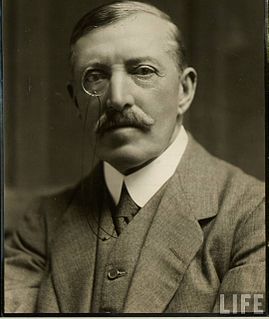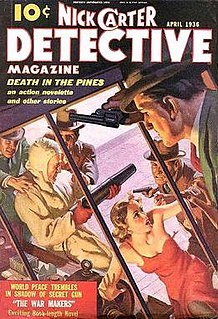
Bertha M. Clay is a literary pseudonym first used by Charlotte Mary Brame (based on the reversal of the initials). [1]

Charlotte Mary Brame was an English novelist.
Contents
After Brame's death on 25 November 1884, Brame's daughter began to write under the name.
At the same time the pseudonym became a house name of Street & Smith, where "a dozen male writers" including John Russell Coryell and Frederick Merrill Van Rensselaer Dey wrote under the name.

Street & Smith or Street & Smith Publications, Inc. was a New York City publisher specializing in inexpensive paperbacks and magazines referred to as dime novels and pulp fiction. They also published comic books and sporting yearbooks. Among their many titles was the science fiction pulp magazine Astounding Stories, acquired from Clayton Magazines in 1933, and retained until 1961. Street & Smith was founded in 1855, and was bought out in 1959. The Street & Smith headquarters was at 79 Seventh Avenue in Manhattan; it was designed by Henry F. Kilburn.
Other authors known to have used the name are Gilbert Patten, William J. Benners, William Wallace Cook, Frederick Dacre, Charles Garvice, Thomas C. Harbaugh, and Thomas W. Henshaw. [1]
William George "Gilbert" Patten was a writer of dime novels and is best known as author of the Frank Merriwell stories, with the pen name Burt L. Standish.
William James Benners, Jr. (1863-1940) was a writer, publisher and historian of dime novels which was a class of popular fiction that flourished in the mid- and late-nineteenth century and into the early twentieth century. Benners was also a poet, actor, and an avid traveler who maintained correspondence with many dime novel authors and aimed to compile a directory of popular writers and bought and sold stories and publishing rights and also penned some dime novels of his own.

Charles Garvice was a prolific British writer of over 150 romance novels, who also used the female pseudonym Caroline Hart. He was a popular author in the UK, the United States and translated around the world. He was ‘the most successful novelist in England’, according to Arnold Bennett in 1910. He published novels selling over seven million copies worldwide by 1914, and since 1913 he was selling 1.75 million books annually, a pace which he maintained at least until his death. Despite his enormous success, he was poorly received by literary critics, and is almost forgotten today.
"Between 1876 and 1928, twenty-seven different publishers issued titles under the name Bertha M. Clay. Six novels were translated into other languages. Bertha M. Clays appeared in fourteen different series and eleven different 'libraries'." Books could appear under different titles, some staying in print for 47 years. [2]
Street and Smith's "new Bertha M. clay Library" ran to more than four hundred volumes. [2]
Eighty-eight Clays are known to be extant. [2]







